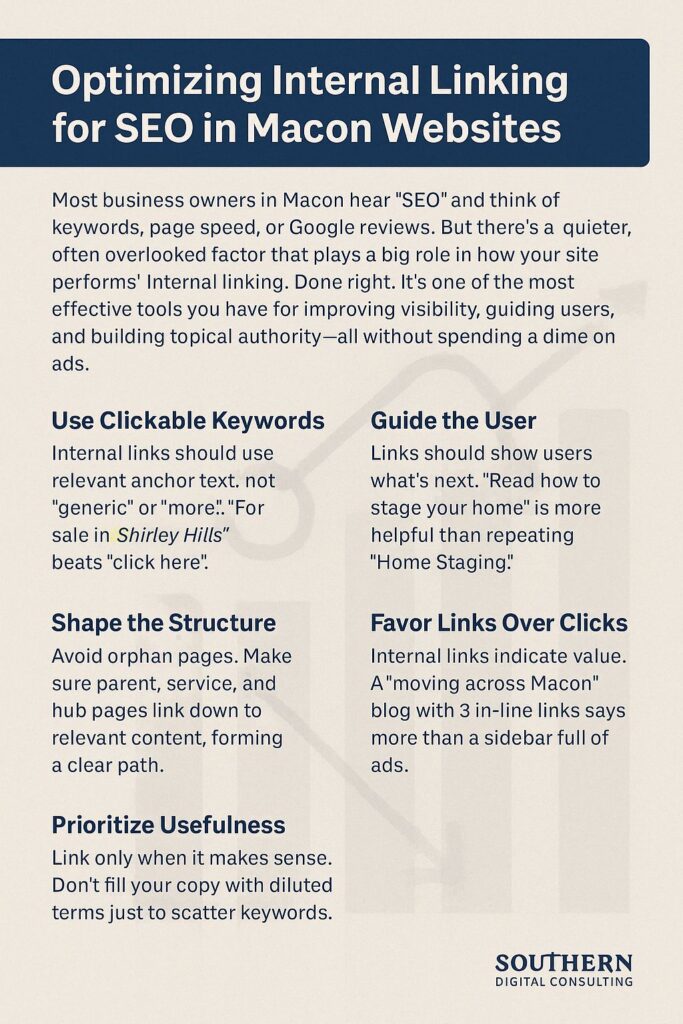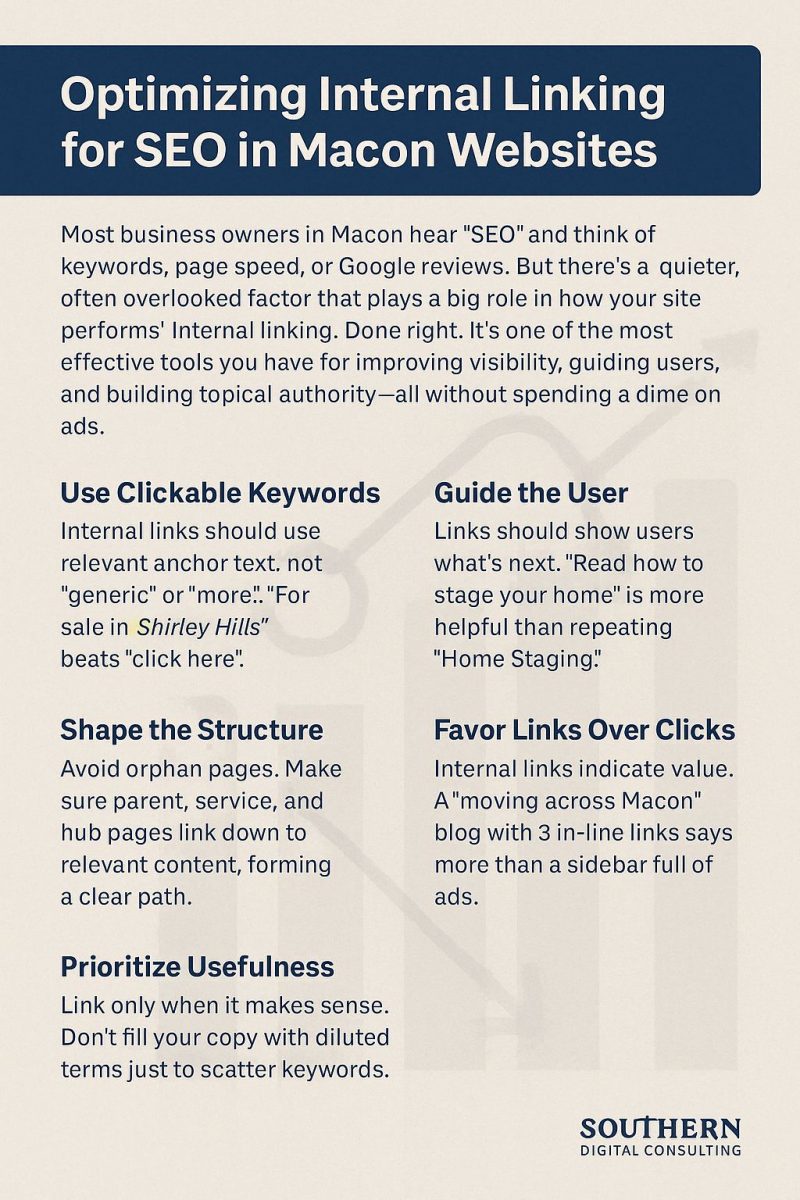Most business owners in Macon hear “SEO” and think of keywords, page speed, or Google reviews. But there’s a quieter, often overlooked factor that plays a big role in how your site performs: internal linking. Done right, it’s one of the most effective tools you have for improving visibility, guiding users, and building topical authority. All without spending a dime on ads. Internal links tell both users and search engines what matters on your site. They shape hierarchy, context, and momentum. This cluster breaks down how Macon-based businesses can structure internal links that not only improve rankings but actually help people navigate with confidence.
Strategic Internal Links That Improve Macon SEO Performance
Internal links aren’t just about clicking around. They’re signals. To Google, they show what pages are important, how content is connected, and what your site is really about. For businesses in Macon, where most web traffic is local and search intent is urgent, strong internal linking can help smaller sites punch above their weight.
Start with your high-traffic pages. Often your homepage or main service pages. These should link out to deeper, more specific pages that support them. For example, a “Roofing Services” page should link to “Emergency Roof Repair in Macon” or “Metal Roofing Options in Bibb County.” This builds depth and keeps users engaged longer.
But don’t stop there. Reverse the flow. Those blog or sub-service pages should also link back up to their parent page. It reinforces relevance and strengthens keyword associations without stuffing.
Don’t scatter links randomly. Be intentional. Use links to guide the reader’s journey. If someone finishes reading about HVAC installation, send them to financing options or maintenance plans. Not your homepage again.
Also, avoid orphan pages. Those with no links pointing to them are invisible to crawlers and users alike. Every page should connect to and from at least one other page.
Finally, check your balance. If one page is getting all the links and others none, you’re creating a top-heavy site. Spread the equity. Internal links are your SEO foundation. Quiet, powerful, and completely under your control.
Anchor Text Best Practices for Local Web Pages
Anchor text is what users click. But it’s also what search engines read. If you get it wrong, your links lose value. If you get it right, they boost both clarity and rankings.
The first rule is simple. Be descriptive. Don’t say “click here” or “learn more.” Say “view our landscaping services in Macon” or “see our latest vinyl siding installations in Gray.” This helps users understand what they’ll get and helps Google associate the link with relevant queries.
Avoid keyword stuffing. There’s a difference between being descriptive and being robotic. “Macon HVAC Macon Heating Repair Macon” isn’t helpful. It’s a red flag. Use long-tail phrases that flow naturally: “We also provide emergency AC repairs for homes across Middle Georgia.”
Vary your anchor text slightly. If every link to your plumbing page uses the same phrase, it starts to look unnatural. Instead, rotate between “plumbing services,” “local plumber in Macon,” and “pipe repair options.”
Keep anchors short. Ideally 3 to 7 words. Longer than that, and users skim past. Shorter, and you lose meaning. Make the link part of a full sentence if possible. “For a deeper look, check out our full guide to attic insulation.”
Also, don’t overlink. If every third sentence is blue, your content becomes noise. One or two internal links per 300 words is a healthy baseline.
Anchor text is small, but mighty. Treat it like signage in a store. Helpful, consistent, and easy to follow.
Planning Link Hierarchy for Topic Clusters in Georgia
If your website’s structure is flat, meaning all pages exist on the same level, you’re missing an opportunity to show authority. Google doesn’t just want keywords. It wants context, and internal linking helps build that context through hierarchy.
Topic clusters are a simple way to organize content. At the top, you have a pillar page. Say, “Home Renovation Services in Macon.” Below that, you create several supporting pages: “Bathroom Remodel Costs,” “Open Floor Plan Renovations,” “Historic Home Upgrades.”
Each subpage links back to the pillar. The pillar links out to each subpage. Together, they form a content cluster that tells Google, “Hey, we really know this topic.” That cluster also keeps users clicking, reading, and staying longer.
For Georgia businesses, this model helps bridge broad and local search intent. The pillar handles general info. The subpages target hyper-specific needs, often tied to location or use case. “Roofing Options for Warner Robins Homes” supports a roofing pillar while hitting a localized long-tail keyword.
Use breadcrumbs, section menus, and contextual links to reinforce structure. And don’t forget internal linking between subpages too. It shows depth and makes your cluster feel more human.
A smart link hierarchy turns your site into a map, not a pile. And when people can navigate easily, so can search engines.
Tools to Audit Internal Linking Structure in Macon Sites
You don’t need a full-time SEO team to clean up your site’s internal links. You just need the right tools and the patience to look under the hood.
Start with Google Search Console. The “Links” report shows which pages are getting internal links and which are being ignored. Sort by “Internal Links (Descending)” and look for pages near zero. Those are your orphans.
Screaming Frog is another great option. Their SEO Spider crawls your site and maps every link. You can visualize structure, see anchor text, and identify broken internal paths. All in one dashboard.
For WordPress users, plugins like Yoast SEO Premium highlight unlinked cornerstone content and suggest internal link opportunities as you write. It’s not perfect, but it’s helpful.
Want to see how users interact with those links? Try Microsoft Clarity or Hotjar. Heatmaps show where people click and where they don’t. You might find that your footer links get ignored, while sidebar CTAs overperform.
Also useful: site search analysis. If users keep typing “contact” into your internal search bar, your link to the contact page probably isn’t obvious enough.
Make audits a quarterly habit. Add internal link checks to your content updates, new page launches, and SEO sprints. In Macon, where many businesses are competing in narrow service categories, a cleaner internal link structure gives you an edge. Both in user experience and organic rankings.
Case Study: Internal Link Optimization for Macon Law Firm
A mid-sized law firm in downtown Macon had solid traffic. But flat conversions. After a quick technical audit, one thing stood out. Their internal links were random, sparse, and inconsistent. Service pages didn’t connect. Blogs lived in isolation. There was no structure guiding users or Google through the site.
We started by mapping their content into clusters. Their personal injury practice became the pillar. Supporting pages like “Car Accident Claims,” “Slip and Fall Cases,” and “Wrongful Death Litigation” were built underneath. Each of these now links back to the main injury page with natural, varied anchor text.
We also reworked their blog. Older posts on insurance disputes now point toward the firm’s “Bad Faith Insurance” page. Guides on statute of limitations link to state law resources on their site. One simple rule: if a page provides context or support for another, they link.
CTAs were added midway through each post, not just at the end. Buttons said things like “See If You Have a Case” or “Read About Macon’s Most Common Accidents.” Always paired with useful pages.
The result? Time on site increased by 38%, bounce rate dropped by 21%, and conversions—form fills and scheduled calls—rose 44% in three months. No redesign. No ads. Just a better internal path.
In markets like Macon, where users often compare 2 to 3 providers before calling, that path is the difference between a bounce and a client.
Want Your Site to Guide Users and Grow Rankings?
We help Macon businesses structure their websites with internal links that don’t just look tidy. They drive traffic, improve search visibility, and keep users moving. If you’re ready to stop losing SEO power on disconnected pages, visit SEO-driven internal linking for Macon websites and let’s build your structure the right way.


